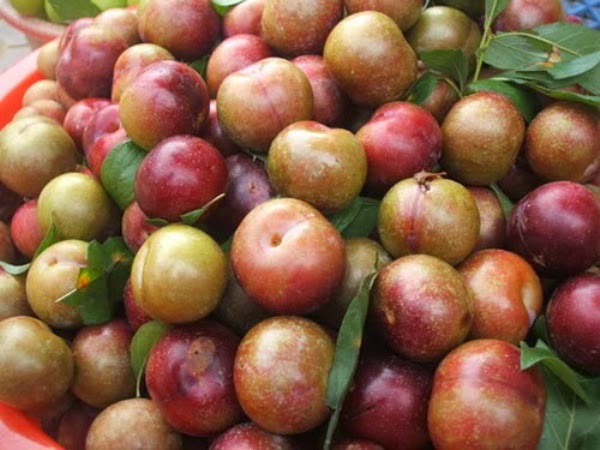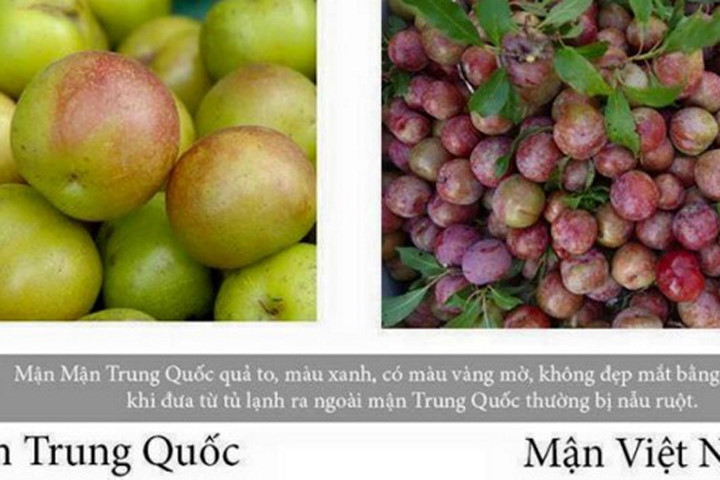How to distinguish Vietnamese plums and Chinese plums
Vietnamese plum usually has sour, bar flavor. Chinese plums eat sweet, softer bowels, but when left in the fridge, they often get gut, eat light and not delicious.
The difference between Vietnamese plum and Chinese plum

Vietnamese plum usually has sour, bar flavor.
Shape
Vietnamese plum is small and not as big as Chinese plum.
Color
Chinese plums are translucent yellow, not as beautiful as Vietnamese plum. Vietnamese plum is red and purple is very eye-catching.
Sweet
Vietnamese plum usually has sour, bar flavor. Chinese plums eat sweet, softer bowels, but when left in the fridge, they often get gut, eat light and not delicious.

All Sapa Lao Cai plums are out of season around mid-July.
All Sapa Lao Cai plums run out of season in the middle of July and the end of July, so later plums are Chinese plums.
Not only that, Sapa Lao Cai plums are also purple, sweet but they are small fruits but not as big as Chinese plums.
Besides, Sapa plums also have plum, but green shell, palpable, yellow intestine and sour taste . The small Ta Van plum is only as small as a thumb and has a beautiful purple color, but this plum is very sour so it is only used to soak wine and make syrup. Another type of plum harvested in Bac Ha district in Sa Pa is light purple, red intestine, apple-sized fruit and sour taste, white chalk on the outside.
How to choose a good plum
The first way to choose delicious plums is based on the appearance . Consumers should choose fresh, delicious, beautiful plums, not bruised, crushed, rotten. In addition, plums have insect bites or nail clippers that are susceptible to invading bacteria, and should not be purchased.
 The outer shell of delicious plums is usually plump and smooth.
The outer shell of delicious plums is usually plump and smooth.
The outer shell of delicious plums is usually plump and smooth. Fresh plums with fresh stalks , or whole bunches, are not soft. Do not buy plums too green or too ripe, but choose alternating colors both blue and red. If there is a layer of white chalk on the fruit, it is fresh plum. Choose plums that are evenly spaced, rounded, not distorted.
Consumers note, after buying plums, store in a refrigerator at a temperature of 4 degrees Celsius, as this will keep the plums fresh and delicious. Leaving plums in hot, humid places will affect plum quality. Before eating, wash the plums with salt water . When buying plums, need to filter again to remove the deep, rotten, damaged fruits.
- How to distinguish Vietnamese pink and standard Chinese pink without correction
- How to distinguish Vietnamese snakehead fish and Chinese bananas
- How to distinguish Korean and Chinese needle mushrooms
- How to distinguish Quang Ninh peanut worms and Chinese devotees
- Plums cure sore throat
- Why is the Vietnamese and Chinese New Year a day different?
- Why are Vietnamese and Chinese calendar different?
- Simple way to identify Chinese vegetables and fruits
- Revealing Chinese fruit
- Discover interesting differences in Vietnamese and Chinese Apple legends
- 6 incredible 'masterpieces' make the whole world 'crouch' in front of ancient Chinese people
- International publication of the Vietnamese genome sequence
 Soaking vegetables in salt water does not remove chemicals but you should still do it
Soaking vegetables in salt water does not remove chemicals but you should still do it You should limit bamboo shoots if you have 1 in 5 of these diseases
You should limit bamboo shoots if you have 1 in 5 of these diseases Mistakes when soaking vegetables in salt water
Mistakes when soaking vegetables in salt water Risk of death when combining shrimp with vitamin C
Risk of death when combining shrimp with vitamin C